 Li-Ion BMS
Li-Ion BMS
|
Home White Paper - Estimating the State Of Charge of Li-Ion batteries Coulomb Counting plus Voltage Translation give reasonable SOC estimates 
There is no direct way of measuring the State Of Charge (SOC) of a Li-Ion battery. There are indirect ways of estimating it, but each suffers from limitations. This paper describes how combining two techniques can result in a reasonable estimate of SOC. Of the various techniques for estimating SOC, two are:
Both techniques are useful, but each by itself is unable to reliably estimate SOC in a Li-Ion battery. In many systems, a simple voltmeter is used as a SOC indicator: the battery voltage decreases more or less linearly as the battery is discharged. This effect is more or less pronounced depending on the battery chemistry. In particular, the voltage in a Lead Acid battery decreases significantly as it is discharged. Knowing the relationship of battery voltage and SOC allows the voltmeter to be calibrated to report SOC: that is, the voltage is translated to an estimated SOC. A major limitation with this technique is that the battery voltage is also affected by temperature and battery current. Knowing the way temperature and current affect the voltage allows one to compensate for those effects to a great extent, allowing Voltage Translation to be a used with many battery chemistries. 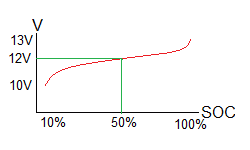
Using Voltage Translation to estimate SOC in a lead acid battery. Unfortunately, for most of its SOC range, the voltage of a Li-Ion battery remains very constant, making Voltage Translation impractical. Yet, the voltage of a Li-Ion battery does change significantly at both ends of its SOC range: the voltage increases rapidly when full, and drops significantly when it starts getting empty. Therefore, Voltage Translation can be use to estimate SOC of a very full or very empty Li-Ion battery. 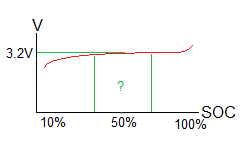
Using Voltage Translation to estimate SOC with Li-Ion cells. Integrating the current into or out of a battery gives the relative value of its charge, just as counting currency in and out of a bank account gives the relative amount in the account. The operative word here is "relative": like all definite integrals, "Coulomb Counting" needs a starting point. If the initial charge in the battery is known, from then on "Coulomb Counting" can be used to calculate its SOC. For example, a 2 A current into a battery, for 3 hours, will add 2 * 3 = 6 Ah to the battery charge. If the battery capacity is 24 Ah, that will increase its SOC by 6 / 24 = 25 %. That's 25 % more than it had been at the beginning; but, without knowing what the beginning SOC was, we do not know the final SOC. 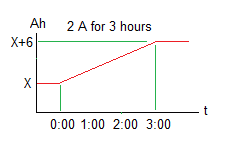
Using Coulomb Counting to estimate relative SOC changes.
Depending on the battery chemistry, Coulomb Counting can be a very accurate technique.
On the other side, Coulomb Counting does work as well with Li-Ion batteries, because of their low leakage and good Peukert exponent. Another limitation of Coulomb Counting is drift. In any integration, any small, constant error in the variable being integrated results in a drift in the result. In the case of Coulomb Counting, any small offset in the measurement of battery current, will result in the SOC drifting up (or down) over time. 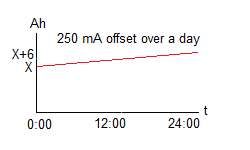
Drift in Coulomb Counting due to small offset in the measured current. Drift can become significant in applications that, for long periods, use very little battery current or shuttle current back and forth:
Therefore, Coulomb Counting can be used to estimate SOC of a Li-Ion battery as long as there's a way of calibrating the SOC at some point, and often enough to overcome drift.
Going back to the bank account analogy: balancing your check book synchronizes the the amount you believe is in your account with the amount that your bank says is in that account.
Similarly, "Coulomb Counting" needs a way to calibrate its result, so that the charge it reports is the actual SOC. Combining these two techniques results in a reasonable way of estimating of SOC in a Li-Ion battery:

Combining Coulomb Counting and Voltage Translation to estimate SOC. If the SOC estimated through Coulomb Counting is uncalibrated (it is not equal to the actual SOC), eventually the battery will be charged or discharged so far, that Voltage Translation can be used to estimate SOC, and calibrate the estimate value. For example, if the actual SOC is 80% but the estimated SOC is 50%, and the Li-ion cell is charging, its voltage soon becomes higher than a threshold (say, 3.4 V), which corresponds to an actual SOC (say, 90 %). At that point, the BMS sets the estimated SOC to 90 %, to calibrate it. 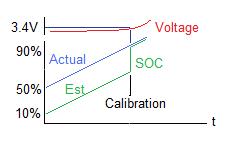
Example of estimated Li-Ion cell charge being much lower than what actual SOC; calibration during charging when cell voltage crosses a threshold. Going back to the issue of drift, let's see how combining the two techniques affects the two applications we considered earlier.
For the above method to work, the capacity of the battery must be known a priori. Otherwise:
In application in which this could present a problem, there is a need to measure battery capacity. If a battery is used in applications where knowing the SOC is crucial (such as Electric Vehicles), there is a need to measure its actual capacity. The battery capacity is measured by integrating its current from completely full to completely empty (or vice-versa). 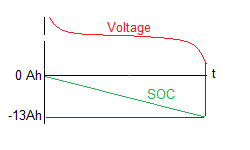
Measuring battery capacity: starting from a full cell, use Coulomb Counting to measure the charge out of it, until discharged (as indicated by its voltage). That charge is the cell's capacity.
The problem is that not all applications will use up all the battery's energy in one session.
And, in many cases, the battery will be recharged fully even though the battery was not completely empty to start with.
In some of the above applications, knowing exactly the SOC or the capacity is not important; for example, in HEVs and PHEVs, there is a gasoline engine to get you home. In others (specifically EVs), knowing the SOC and the capacity is important, and therefore the limitations of the above techniques are a concern.
Davide Andrea, Elithion, 1/10/09 | ||
© 2008~2025 Davide Andrea. All rights reserved, except where noted by CC mark. Page published on Oct 24 2021. Graphic design by morninglori